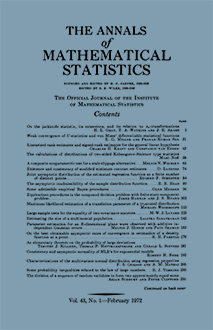Abstract
The statistic $V_{NM}$ is a two-sample statistic which may be used to test the null hypothesis $H_0$, that two samples, sizes $N$ and $M$, come from identical populations. It is an adaptation of the Kolmogorov two-sample statistic, and is defined by $V_{NM} = \sup_{-\infty<x<\infty} (F_N(x) - G_M(x)) - \inf_{-\infty<x<\infty} (F_N(x) - G_M(x))$ where $F_N(x), G_M(x)$ are the sample cumulative distribution functions. A single-sample analogue $V_N$ is defined by replacing $G_M(x)$ in the formula above by a hypothesised distribution function $F(x)$. For large values of $V_{NM}$ or $V_N, H_0$ will be rejected. These statistics are particularly useful for observations recorded as points on a circle; the value obtained for $V_N$ or $V_{NM}$, in contrast to that of the corresponding Kolmogorov statistic, does not depend on the choice of origin. Kuiper (1960) proved this result and suggested the use of the $V$ statistics for the circle. He also gave series approximations to the distributions of $N^{\frac{1}{2}}V_N$ and $N^{\frac{1}{2}}V_{NN}$, for large $N$, on the null hypothesis $H_0$. Reference to a distribution will henceforth be assumed to refer to the distribution on the null hypothesis. The $V_{NN}$ statistic had earlier been investigated by Gnedenko and co-workers (see Gnedenko (1954)), who used it for observations on a line; the $V$ statistics may be expected to be more powerful than the Kolmogorov statistics for certain alternatives. Gnedenko (1954) gives the exact distribution of $V_{NN}$. The exact distribution of $V_N$, in the upper and lower tails, has recently been given by Stephens (1965). In this paper we make the two-sample goodness-of-fit test available for a wide range of sample sizes by giving tables of the distribution of $V_{NM}$. In the next section a formula is given with which the $V_{NM}$ statistic may be calculated from the ranks of the two samples, and then the goodness-of-fit tests are set out. These are called exact or approximate tests, depending on whether the probabilities used are calculated from exact or approximate formulae. In Section 3 the construction of the tables is described. To find percentage points for large $N$, we develop in Section 3.3 a series expansion for the distribution of $N^{\frac{1}{2}}V_{NN}$ which differs from that given by Kuiper; the probabilities given by the two expansions are compared in Table 4, and the new series clearly gives the better results.
Citation
Urs R. Maag. M. A. Stephens. "The $V_{NM}$ Two-Sample Test." Ann. Math. Statist. 39 (3) 923 - 935, June, 1968. https://doi.org/10.1214/aoms/1177698324
Information





